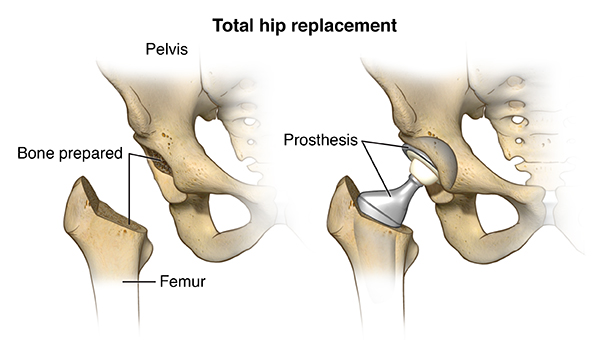
Total hip replacement (or hip arthroplasty) is a technique that has become widespread in recent years in response to the need for improving hip joints that have been damaged by injury or arthritis. Joint replacement surgery may offer the best treatment option for long-term improvement for the hip joint when other treatments have proven inadequate. In most cases, having a total hip replacement reduces joint pain and means a return to pain-free movement.
Hip Surgeries Performed
Relief from pain is the greatest benefit and the major reason for hip replacement surgery. The procedure offers other benefits, such as:
There are possible risks and complications that may happen through hip replacement surgery associated with anesthesia, including respiratory or cardiac malfunction. Other complications include:
Patients at increased risk for complications are those with severe rheumatoid arthritis or systemic lupus. In addition, patients with insulin-dependent (type 1) diabetes, malnourishment, hemophilia, or those who have had previous prosthetic joint infections are at higher risk. Make sure to contact your orthopaedic surgeon immediately, if you experience any of these problems after surgery.
Joint replacements do not last forever, usually 10-15 years. Hip revision surgery may become necessary when an artificial hip becomes painful. Learn more information on hip revision surgery.
Several variables affect the ultimate success of hip replacement surgery. These include the strength of the patient’s bones and muscles and his or her general health and lifestyle. Commitment to a rehabilitation program is also an important part of the recovery process, since improvement to the hip joint is determined by the patient’s rehabilitation effort.
Post-operative visits help your surgeon know that your hip is healing well. Make sure to schedule your first evaluation within the recommended time frame indicated by your surgeon. This recommended timeframe is 4 to 6 weeks following your hip replacement surgery. Also request that any X-rays be sent to your orthopaedic surgeon’s office. X-rays are typically taken the week of surgery, at 12 months and then yearly.
If you have a problem before you schedule your return appointment, make sure to call your doctor’s physician assistant immediately.
In addition to the first follow up appointment after discharge, this additional schedule is recommended:
It is important to comply with this schedule and to see your doctor regularly for routine office visits to ensure safe and effective recovery from total hip replacement.